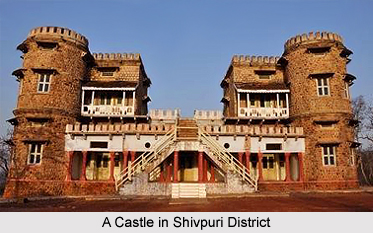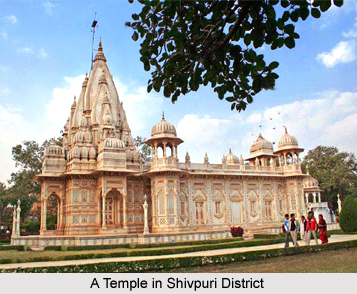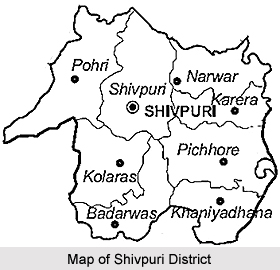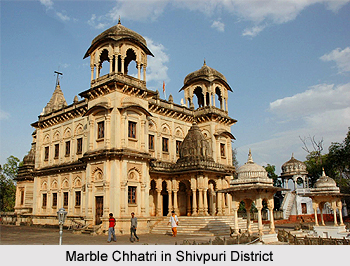 Shivpuri district in Madhya Pradesh is mostly laid out over small hilltops. These hill tpos are covered with deciduous forests where the slope is gentle with verdant vegetation. The landscape is generally pleasing. The district has Narwar town (Princely State of Narwar) of historical importance just east of the Kali Sind River. The town Shivpuri is the head quarter of the district.
Shivpuri district in Madhya Pradesh is mostly laid out over small hilltops. These hill tpos are covered with deciduous forests where the slope is gentle with verdant vegetation. The landscape is generally pleasing. The district has Narwar town (Princely State of Narwar) of historical importance just east of the Kali Sind River. The town Shivpuri is the head quarter of the district.
History of Shivpuri District
The district derives its name from Shiva. It was known earlier by the name "Sipri." The Shivpuri place first found a mention during the times of Mughal rule in India. In the year1564, when Emperor Akbar is stated to have halted at this place, Shivpuri District was mentioned in the history of India. During that period, it formed a part of Narwar Sarkar.
 The district was known as Narwar district during the times of Gwalior State, although its Headquarter was at Shivpuri. Shivpuri remained with the Kachhawaha Rajputs upto 1804 when it was taken over by Scandia`s. It was captured by the British East India Company in 1817 but returned to Scandia`s next year and it continued to be a part of Gwalior state since then. In 1859, it is said that the great Indian leader of the Sepoy Mutiny, 1857, Tantia Tope was hanged near the present Collectorate. Shivpuri was constituted as a district in erstwhile Madhya Bharat and continues as such with practically no change since 1951.
The district was known as Narwar district during the times of Gwalior State, although its Headquarter was at Shivpuri. Shivpuri remained with the Kachhawaha Rajputs upto 1804 when it was taken over by Scandia`s. It was captured by the British East India Company in 1817 but returned to Scandia`s next year and it continued to be a part of Gwalior state since then. In 1859, it is said that the great Indian leader of the Sepoy Mutiny, 1857, Tantia Tope was hanged near the present Collectorate. Shivpuri was constituted as a district in erstwhile Madhya Bharat and continues as such with practically no change since 1951.
Geography of Shivpuri District
Shivpuri district is bounded on the North by Morena District, Gwalior District and Datia districts, on the East by Jhansi district of U.P, on the West by Kota district of Rajasthan and on the South by Guna district. It covers the total area of 10298 square kilometres. The district is located at 24.6ø to 25.6ø latitude and 77.0ø to 78.4ø longitude. Shivpuri has a mix of cool and dry temperature. In summer, the temperature is extended to 42øC. The average annual rainfall is 875 milimeters. There are four main rivers namely the Parbati River, the Sindh River, the Kuno River and the Betwa River, which pass through the district.
Demography of Shivpuri District
Shivpuri District had a total population of 1,725,818. Out of which, the male and female were 919,405 and 806,413. The population density of Shivpuri district for 2011 is 168 people per sq. km. The average literacy rate of Shivpuri district in 2011 was 63.73. The male and female literacy rate was 76.21 and 49.47 respectively.
Culture of Shivpuri District
The local language of the district is Hindi Language. Among the cultural festivals of Shivpuri Holi, Dussehra, Navratri, Diwali are the main festivals of that area.
 Education of Shivpuri District
Education of Shivpuri District
There are eight colleges for Higher Education in Shivpuri District. Out of these eight coleges for higher education, six are government colleges and the private firms run rest of the two. Such colleges are D.I.E.T Institute of Shivpuri, ITI Institute of Shivpuri, Nurses Training School, Forest Training School., Vetenary Training College, Panchayat Training School, Aganwandi Workers Training School and Physical Training College.
Economy of Shivpuri District
Shivpuri is mainly an agricultural district and so cultivation is the main occupation of the people. Rice, Jowar, Bajra, Maize, Wheat and Barley are the main cereal crops. Gram and Tur (Arhar) are the main pulses grown in the district, Sugarcane, condiments and spices; sesame (til) and linseed are other crops of the district. Shivpuri District is a growing industrial region. Handicraft is an emerging employment sector for poor people. Leather industry is also gaining popularity among lower class people. There are two centers of Sericulture industry in Kolaras and Pohri Block.
Tourism of Shivpuri District
Shivpuri is enriched with various tourist attractions. Shivpuri has the big attraction of its natural beauty and vast cultural heritage. There are many tourist spots in Shivpuri District. These are as follows:
George Castle- George Jivajirao Scindia, the Maharaja of Gwalior built the famous George Castle. The ideal time to visit the castle is at sunset. The castle located at the central region of the Park provides a wonderful panoramic view of Sankhya Sagar and the forest around. This castle was built by the Gwalior royalty for an overnight halt for tiger shooting by British King George V, while he was to pass that way during his visit to India in 1911. The King could shoot a tiger on the way itself and hence, moved ahead through the Madhav National Park.
Madhav Vilas Palace- The Madhav Vilas Palace, which was the summer palace of the Scindias, looks intensely alluring, dressed in soft shade of rose pink. It is popularly known, is attired with marble floors, iron columns, graceful terraces and the Ganpati mandap (The Temple of Lord Ganesha). From the tall structure, one can get a splendid view of Shivpuri town and Madhav National Park itself. Now this grand palace has converted in to the training center of Intelligence Bureau of Government of India, which is among the few training centers of Intelligence Bureau.
Chhatris- The royal chhatris (Cenotaphs) are dedicated to Scindias in Shivpuri. Scindia princes erected the graceful, intricately embellished Marble chhatris (cenotaphs). The chhatris of Madhav Rao Scindia and dowager queen Maharani Sakhya Raje Scindia, are facing each other across a water tank in an enchanting blend of Hindu and Islamic architectural styles, with their shikhara - type spires and Rajput and Mughal pavilions. Ceremonially attired retainers, with flowers and incense tend to both cenotaph house life-size images of the Scindias, and these religiously, daily.
Sakhya Sagar-The famous lakes Sakhya Sagar and Madhav Sagar were created on Manier River in 1918. On the shores of the lake and connected to it by a broad pier is a boat club, an airy and delicate structure with glass panels. However, nowadays boating has been banned keeping in view the safety of lives of tourists. Edging the forests of the Madhav National Park is the Sakhya Sagar Lake, habitat of a variety of reptiles.
Narwar: Narwar is 41 km from Shivpuri. It is the medieval fortress of Narwar. The fort is situated atop a hill about 500 feet above ground level and has an area of 8 sq. km. At one time, it was the capital of Raja Nal of Naisadha, whose love for Damyanti has been mentioned in detail in the Mahabharata. The architecture of the fort and palaces is Rajput in style with flat ceiling, fluted columns and multifoil arches. The inner walls of the palaces have been decorated with bright paint and glass beads.
Surwaya: This place is situated 21 km from Shivpuri. Noteworthy at this place are the remains of a fort within which are housed three Hindu temples, a monastery and a step-well. The three temples are dedicated to Lord Vishnu and reveal traces of extremely fine carvings.
Madhav National Park: Madhav National Park lies between Agra-Mumbai road and Jhansi-Shivpuri Road. It is spread over an area of 157.58 Sq. kms. A drive through the park watching animals is very exhilarating experience. The nilgai, sambar, chausingha, black buck, sloth bear, leopard and the common langur are the other inhabitants of the sprawling park. The national park is equally rich in bird life; Chandpata, the artificial lake, is the winter abode of migratory geese, pochard, pintail, teal, mallard and gadwall. Other residents include the cormorant, laggar falcon, paradise flycatcher and golden oriole.
 The species of trees commonly found in the district are Khair, Kardhai, Dhow, Salaj, Tendu, Palas, Mahua, Karch, Karey, Saja, Koha, Jamun, Saj.Dhaman Kaim, Semal, Tinach and Amaltas. The normal height of a tree is about 150 to 200 and the girth is 40 cm to 50 cm.
The species of trees commonly found in the district are Khair, Kardhai, Dhow, Salaj, Tendu, Palas, Mahua, Karch, Karey, Saja, Koha, Jamun, Saj.Dhaman Kaim, Semal, Tinach and Amaltas. The normal height of a tree is about 150 to 200 and the girth is 40 cm to 50 cm.
Shivpur is well connected with the all the transporetation media in the country. The nearest airport to Shivpuri is Gwalior. This airport is well connected with Delhi, Bhopal, Indore and Mumbai. Nearest main railheads from Shivpuri are at Jhansi (101 Kms) and Gwalior (120 Kms) which are on the Delhi-Mumbai and Delhi-Chennai main lines. However, Shivpuri has its own railway station and the trains passes through Shivpuri are Shivpuri is connected by regular bus services with Gwalior, Indore, Bhopal, Jhansi and Ujjain. Shivpuri is 120 kms away from Gwalior on Agra-Mumbai Road and 90 kms away from Jhansi.






